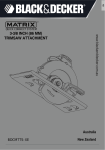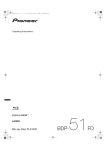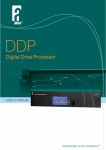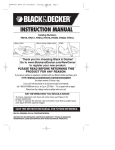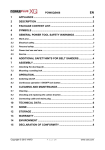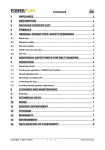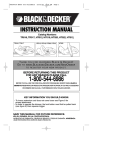Download Black & Decker BDCMTOSS Instruction manual
Transcript
QUICK CONNECT SYSTEM www.blackanddecker.com.au Oscillating Tool Attachment Australia BDCMTO-XE New Zealand PARTS AND FEATURES 1. 2. 3. 4. 5. 6. Oscillating tool attachment Accessory clamping lever Accessory holder Sanding platen Sand sheets Plunge cut blade 4 5 3 1 6 2 Additional accessories are available at extra cost from your local Black & Decker dealer. 2 (Original instructions) ENGLISH Intended use Your Black & Decker multi-purpose tool has been designed for a wide range of DIY applications. Using the oscillating tool head , this tool is intended for DIY applications such as sanding operations. It is also suitable for cutting wooden materials, plastic, gypsum, non-ferrous metals and fastening elements (e.g., unhardened nails, staples), working soft wall tiles and scraping of small surfaces. This tool is intended for consumer use only. Safety instructions : General power tool safety warnings WARNING! To reduce the risk of injury, the user must read the instruction manual. General power tool safety warnings @ @ WARNING! Read all safety warnings and all instructions. Failure to follow the warnings and instructions listed below may result in electric WARNING! Read all safety warnings and all instructions provide with your power unit (BDCDMT108-XE, BDCDMT180-XE) before using this accessory. WARNING: Read all safety warnings and all instructions. Failure to follow the warnings and instructions may result in electric shock, fire and/or serious injury. SPECIfIC SAfETy RULES • Disconnect power before using tool near live wires or where there may be hidden wiring. Cutting accessory contacting a “live” wire may make exposed metal parts of the power tool “live” and could give the operator an electric shock.” Always check for hidden wiring, gas lines, or other utilities before performing any material cutting or removal operations with the tool. • hold power tool by insulated gripping surfaces, when performing an operation where the cutting accessory may contact hidden wiring or its own cord. Cutting accessory contacting a “live” wire may make exposed metal parts of the power tool “live” and could give the operator an electric shock. • Use clamps or another practical way to secure and support the workpiece to a stable platform. Holding the work by hand or against your body leaves it unstable and may lead to loss of control. • wait for the cutter to stop before setting the tool down. An exposed cutter may engage the surface leading to possible loss of control and serious injury. • Do not operate this tool for long periods of time. Vibration caused by the operating action of this tool may cause permanent injury to fingers, hands, and arms. Use gloves to provide extra cushion, take frequent rest periods, and limit daily time of use. • Always hold the tool firmly with both hands for maximum control. Keep proper footing and balance at all times. This enables better control of the power tool in unexpected situations. • Do not restart the cutting operation in the workpiece. Let the tool reach full speed and carefully re-enter the cut. • Do not “jam” the cut-off saw blade or apply excessive pressure. Do not attempt to make an excessive depth of cut. • keep your hands away from cutting area. Do not reach under the material being cut. • Do not use dull or damaged blades. Bent blade can break easily or cause kickback. Exercise extreme caution when handling the accessories. The accessories are very sharp. Wear protective gloves when changing cutting accessories. Accessories become hot after prolonged usage. • Before scraping, check workpiece for nails. If there are nails, either remove them or set them well below intended finished surface. Striking a nail with accessory edge could cause the tool to jump. • Do not wet sand with this tool. Liquids entering the motor housing are an electrical shock hazard. 3 ENGLISH (Original instructions) • Never work in area which is soaked with a liquid, such as a solvent or water, or dampened such as newly applied wallpaper. There is an electrical shock hazard when working in such conditions with a power tool and heating of the liquid caused by scraping action may cause harmful vapors to be emitted from workpiece. • Do not use sandpaper intended for larger sanding pads. Larger sandpaper will extend beyond the sanding pad causing snagging, tearing of the paper or kick-back. Extra paper extending beyond the sanding pad can also cause serious lacerations. wARNING: ALWAYS use safety glasses. Everyday eyeglasses are NOT safety glasses. Also use face or dust mask. ALWAYS WEAR CERTIFIED SAFETY EQUIPMENT: •ANSI Z87.1 eye protection (CAN/CPA Z94.3), •ANSI S12.6 (S3.19) hearing protection, •NOSH/OSHA respiratory protection. • Avoid prolonged contact with dust from power sanding, sawing, grinding, drilling, and other construction activities. wear protective clothing and wash exposed areas with soap and water. Allowing dust to get into your mouth, eyes, or lay on the skin may promote absorption of harmful chemicals. wARNING: Use of this tool can generate and/or disperse dust, which may cause serious and permanent respiratory or other injury. Always use NOSH/OSHA approved respiratory protection appropriate for the dust exposure. Direct particles away from face and body. wARNING: Always wear proper personal hearing protection that conforms to ANSI S12.6 (S3.19) during use. Under some conditions and duration of use, noise from this product may contribute to hearing loss. PRECAUTIONS TO TAkE whEN SANDING PAINT 1. Sanding of lead based paint is NOT RECOMMENDED due to the difficulty of controlling the contaminated dust. The greatest danger of lead poisoning is to children and pregnant women. 2. Since it is difficult to identify whether or not a paint contains lead without a chemical analysis, we recommend the following precautions when sanding any paint: PERSONAL SAfETy 1. No children or pregnant women should enter the work area where the paint sanding is being done until all clean up is completed. 2. A dust mask or respirator should be worn by all persons entering the work area. The filter should be replaced daily or whenever the wearer has difficulty breathing. See your local hardware store for the proper N.I.O.S.H. approved dust mask. 3. NO EATING, DRINKING or SMOKING should be done in the work area to prevent ingesting contaminated paint particles. Workers should wash and clean up BEFORE eating, drinking or smoking. Articles of food, drink, or smoking should not be left in the work area where dust would settle on them. ENVIRONMENTAL SAfETy 1. Paint should be removed in such a manner as to minimize the amount of dust generated. 2. Areas where paint removal is occurring should be sealed with plastic sheeting of 4 mils thickness. 3. Sanding should be done in a manner to reduce tracking of paint dust outside the work area. CLEANING AND DISPOSAL 1. All surfaces in the work area should be vacuumed and thoroughly cleaned daily for the duration of the sanding project. Vacuum filter bags should be changed frequently. 2. Plastic drop cloths should be gathered up and disposed of along with any dust chips or other removal debris. They should be placed in sealed refuse receptacles and disposed of through regular trash pick-up procedures. During clean up, children and pregnant women should be kept away from the immediate work area. 3. All toys, washable furniture and utensils used by children should be washed thoroughly before being used again. 4 (Original instructions) ENGLISH SyMBOLS The label on your tool may include the following symbols. The symbols and their definitions are as follows: V ..................volts A...................amperes Hz................hertz W ..................watts ................alternating current min ..............minutes no .................no load speed .............direct current ................Class I Construction ..................earthing terminal (grounded) ................safety alert symbol ................Class II Construction opm.............. oscillations per minute (double insulated) ............Read instruction manual before use ..................Use proper respiratory protection ................Use proper eye protection ..................Use proper hearing protection SAVE ThESE INSTRUCTIONS ACCESSORIES • Accessoryadaptorsoldseparately.Confirmwithmanufacturertoensureaccessoryiscompatible. • Otheroscillatingtoolaccessoriesareavailableforawidearrangeofapplicationsincluding scraping, drywall cutting, grout removal, thin set removal, and more. Please visit www.blackanddecker.com for more details. INTENDED USE DETAIL SANDING Sanding in extremely tight areas otherwise difficult to reach and require hand sanding. Select a high oscillating frequency. Sand with continuous motion and light pressure. Applying excessive pressure does not increase material removal; but will prematurely wear sanding sheets. fLUSh CUTTING Remove excess wood from door jamb, window sill and/or toe kick. Removing excess copper or PVC pipe. REMOVAL wORk Carpets & backing, old tile adhesives, caulking on masonry, wood and other surfaces. REMOVAL Of ExCESS MATERIALS Tile grout, plaster, mortar splatters, concrete on tiles, sills. PREPARATION Of SURfACES New floors and tiles. OPERATING INSTRUCTIONS wARNING: Shock hazard. Under no circumstances should this product be used near water. wARNING: Risk of lacerations or burns. Do not touch work piece or accessory immediately after operating the tool. They can become very hot. Handle carefully. Always allow accessories and work piece to cool before handling. wARNING: To reduce the risk of injury, turn off and remove battery from tool or disconnect plug from power source before making any adjustments or removing or installing attachments or accessories. Remove any accessory from the attachment before removing or installing the attachment. NOTE: Refer to Power Unit instruction manual before operating this tool for all safety warnings and details on installing and removing attachments. OPERATION • Toswitchthetoolon,pressthevariablespeedswitchonthe power unit. The tool speed depends on how far you press the switch. • Toswitchthetooloff,releasethevariablespeedswitch. NOTE: This attachment only operates in the forward direction, the forward/reverse slider of the Power Unit should not be able to be switched to reverse. A 5 ENGLISH (Original instructions) INSTALLING/REMOVING ACCESSORIES This tool features a tool-free accessory changing system. This allows for faster accessory changes without the need for wrenches or hex keys like other oscillating tool systems. •Graspthetoolandsqueezetheaccessoryclampingleveras B shown in figure A. • Cleananyresidualdebrisfromthetoolshaftandtheaccessoryholder. •Slidetheaccessoryintotheaccessoryholdermakingsurethe accessory engages all eight pins on the holder and is flush with the surface of the holder. •Releasetheaccessoryclamplever. • Someaccessories,suchasscrapersandbladescanbemountedat an angle if required as shown in figure B. PLUNGE CUTTING - fIGURE C wARNING: Hold saw firmly with both hands for all cutting operations. wARNING: Inspect work area for hidden electrical wiring, gas pipes or water pipes before making blind or plunge cuts. Failure to do so may result in electrical shock, fire, explosion, or property damage. wARNING: ALWAYS use safety glasses. Everyday eyeglasses are NOT safety glasses. Also use face or dust mask if cutting operation is dusty. ALWAYS WEAR CERTIFIED SAFETY EQUIPMENT. wARNING: CUT HAZARD. Before cutting any type of material, be sure it is firmly anchored or clamped to prevent slipping. wARNING: CUT HAZARD. Let the tool work at its own pace. Do not overload, blade breakage may occur. wARNING: CUT HAZARD. This tool has no provision to lock the switch in the ON position, and should never be locked in the ON position by any other means. To make a cut: •Clearlymarkthedesiredcuttingarea. •Toswitchthetoolon,pullthevariablespeedtriggeronthepower unit. The tool speed depends on how far you pull the trigger. •Switchthetoolonbeforeapplyingpressureandslowlyfeedthe plunge cut blade into the workpiece at the marked location. C wARNING: CUT HAZARD. Ensure the blade is not in contact with cutting surface before starting saw. •Advancethebladealongthecuttinglineuntilcutiscompleted. Don’t force the tool; let the blade cut at its own speed. •Toswitchthetooloff,releasethetrigger. NOTE: Always use the appropriate type of saw blade for the work piece material and type of cut. Cut only with sharp blades; they cut cleaner, faster and put less strain on the motor while cutting. SANDING wARNING: fire hazard. When working on metal surfaces, do not use a vacuum cleaner because sparks are generated. Wear safety glasses and a dustmask. Due to the danger of fire, do not use your sander to sand magnesium surfaces. Do not use for wet sanding. • Toswitchthetoolon,pullthevariablespeedtriggeronthepowerunit.Thetoolspeeddependson how far you pull the trigger. • Toswitchthetooloff,releasethetrigger. NOTE: Do not rest fingers on platen during use. Move it in long sweeping strokes across the surface, letting it do the work. Light pressure is all that is required for sanding. Excessive pressure will slow the tool and produce inferior results. Check your work often, product is capable of removing material rapidly. Excessive force will reduce the working efficiency and cause motor overload. Replacing the sanding sheet regularly will maintain optimum working efficiency. NOTE: Always ensure the workpiece is firmly held or clamped to prevent movement. Any movement of the material may affect the quality of the sanding finish. 6 (Original instructions) INSTALLING/REMOVING SANDING ShEETS - fIGURE D A diamond shaped platen uses a hook and loop adhesion system to attach the sanding sheets. The platen allows you to use it on large flat surfaces and tight spots or corners. •Attachthesandingplatenasdescribedunder“Installing/Removing Accessories.” •Aligntheedgesonthesandingsheet,withtheedgeofthesanding platen and press the sanding sheet onto the platen. •Firmlypressthebasewiththesandingsheetattachedagainsta flat surface and briefly switch the tool on. This provides for good adhesion between the platen and the sanding sheet, and also helps to prevent premature wear. •Whenthetipofthesandingsheetbecomesworn,detachthesheetfrom the platen, rotate and reapply. ENGLISH D hELPfUL hINTS •Alwaysensuretheworkpieceisfirmlyheldorclampedtopreventmovement.Anymovementof the material may affect the quality of the cutting or sanding finish. •Donotstartsandingwithouthavingthesandpaperattachedtosandingplaten. •Usecoarsegritpapertosandroughsurfaces,mediumgritforsmoothsurfacesandfinegritfor the finishing surfaces. If necessary, first make a test run on scrap material. •Excessiveforcewillreducetheworkingefficiencyandcausemotoroverload.Replacingthe accessory regularly will maintain optimum working efficiency. •Donotallowthesandpapertowearaway,itwilldamagethesandingplaten. TROUBLEShOOTING Problem •Unitwillnotstart. Possible Cause •Attachmentisnotsecured. Possible Solution •Makecertaintheattachmentisfully pushed into the Power Unit. MAINTENANCE Use only mild soap and damp cloth to clean the tool. Never let any liquid get inside the tool; never immerse any part of the tool into a liquid. IMPORTANT:ToassureproductSAFETYandRELIABILITY,repairs,maintenanceand adjustment (other than those listed in this manual) should be performed by authorized service centers or other qualified service personnel, always using identical replacement parts. ACCESSORIES wARNING: Theuseofanyaccessorynotrecommendedforusewiththistoolcouldbehazardous. Recommendedaccessoriesforusewithyourtoolareavailablefromyourlocaldealerorauthorized service center. If you need assistance regarding accessories, please call: 1-800-444-224 Technical data when operate with 18V MATRIX unit Oscillating Tool No-load speed Oscillating angle Weight BDMTO-XE min-1 0-18500 (OPM) Degrees 2.8 g 545 Vibration total values (triax vector sum) according to EN 60745: Cutting wood (ah, CW) 5.0 m/s2, uncertainty (K) 1.5 m/s2 Cutting metal (ah, CM) 8.0 m/s2, uncertainty (K) 1.5 m/s2 Sanding (ah,) 10.3 m/s2, uncertainty (K) 1.5 m/s2 Level of sound pressure according to EN 60745: Sound pressure (LpA) 86.5 dB(A), uncertainty (K) 3 dB(A) Sound power (LWA) 97.5 dB(A), uncertainty (K) 3 dB(A) 7 Australia & New Zealand Stanley Black & Decker 82 Taryn Drive, Epping, VIC 3076 Australia Tel.1800 444 224 (Aust) or Tel. 0800 339 258 (NZ) 90589509 REV-0 07/2012









